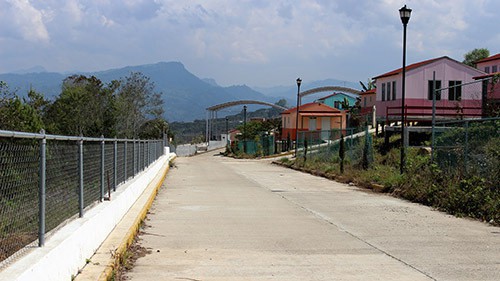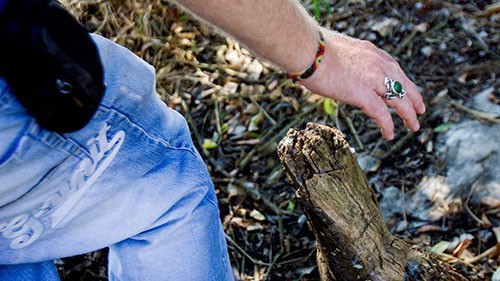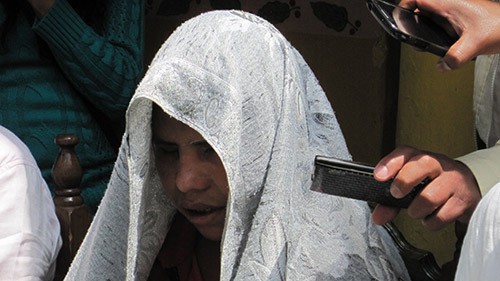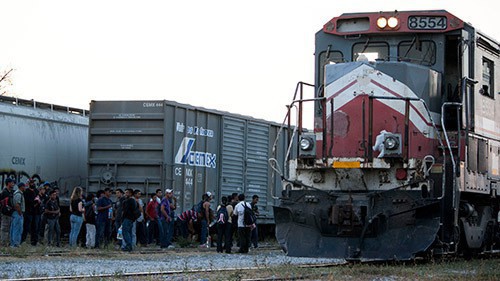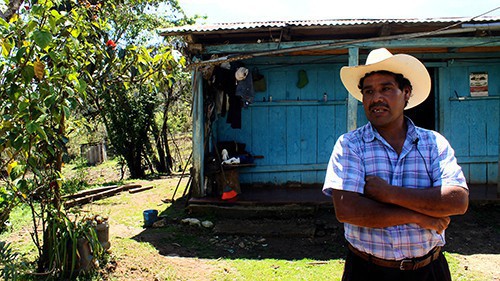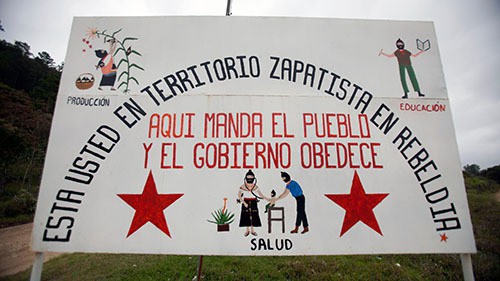
Court order: Basketball binds government, people in state of Chiapas
By Steven Totten / Cronkite Borderlands Project
Published Sept. 25, 2014
ZINACANTAN, Chiapas, Mexico — As he descends the curving hillside road into this city of 30,000 in the highlands of Chiapas, Juan de la Cruz shifts his rickety Volkswagen Pointer into neutral and slows to a stop.
“What’s the first thing you see here?” de la Cruz asks with a grin.
It’s impossible to miss: You see basketball courts.
They’re a common sight in Chiapas. The courts that frame Zinacantan’s entrance are among thousands scattered throughout these highlands and the rest of the state. Mexico may consider soccer its national sport, but basketball reigns supreme in Chiapas.
“Wherever you go in Chiapas, you’ll find a basketball court,” de la Cruz says. “It seems like a new court is built every day.”
The sport has become a part of life, even a tradition, for the Mayan tribes that inhabit the central highlands, like the Tzeltal, Tzotzil and Ch’ol. But the courts are more than just a place to shoot hoops. In the same way a small U.S. town might use a high school gymnasium as a civic center, indigenous communities in Chiapas towns like Zinacantan, Chamula or Chenalhó use the courts for festivals, meetings, and all kinds of gatherings, because they are often the largest and sturdiest infrastructure in the village.
While the courts serve as the foundation for the development of communities they’ve also been sites of tragedy and destruction.
Indigenous groups and the Mexican government have a long history of conflicts, especially in Chiapas. In 1994, the state faced one of the largest indigenous rebellions ever in Mexico. In a violent 11-day struggle, the Zapatista Army of National Liberation took over six municipalities to protest the ever-growing gap between the poor and the elite. More than 100 people died and hundreds more were injured in the fighting.
While tensions have cooled considerably in the past 20 years, the government has used the basketball courts to put down the occasional flare-up, landing helicopters on them and detaining – some say torturing – protesters there.
But to de la Cruz, the courts are a place for solidarity, not conflict.

“Basketball is how our indigenous communities gain respect,” he says. “It’s how we are taken into account.”
He speaks with conviction. As the Central Highlands delegate for the Ministry of Youth, Sports and Recreation in the state of Chiapas, it’s de la Cruz’s responsibility to promote athletic activity in the region.
It’s a job that de la Cruz has been doing for 17 years, and he has no plans of stopping. Despite the constant distrust between indigenous groups and the government, de la Cruz believes he was meant to do this work.
“This is my passion,” he says. “To work alongside my people, my race. To make them strong and to give them recognition.”
“Just a part of life”
Growing up in Zinacantan and neighboring San Cristóbal de las Casas, de la Cruz has spent his life playing basketball. The sport is more than a hobby – it’s an integral part of his environment. For de la Cruz, basketball transcends political, religious and social conflicts.
“There’s no difference between anyone on a basketball court,” he says.
De la Cruz embodies his statement. Despite his government title, he dresses in athletic sweats and T-shirts with sports logos. When he meets with community members, they affectionately call him “Juanito.”
In the gap between the indigenous people and the government, de la Cruz seems to be a bridge. But it wasn’t his relationship with the community that got him his job. He says it was his skill on the court.
When the Chiapas government organized a municipal basketball tournament in 1997, de la Cruz put a team together in Zinacantan. After his team won the tournament for two consecutive years, government officials wanted to know how he did it.
“They asked me how much I was being paid to train my team,” he recalls. “I told them I was just doing it because I liked it. So they asked me to keep training players in the community, and I’ve been doing it ever since.”
De la Cruz’s passion for his work has paid off. There are now 80 teams – 10 of of them women’s teams – in the municipal leagues around the central highlands of Chiapas. Last year, Chamula’s team, Los Fantasmas, placed third in the national basketball competition.
“We beat the Federal District, Sinaloa and Chihuahua teams, but lost by three points to Nayarit,” de la Cruz says. “They were all much taller than us, but our small size made us quick on our feet.”
De la Cruz stands about 5 feet 4 inches, average for a man in Zinacantan. But Chiapas’ courts generally hew to the standard 10-foot high rims.
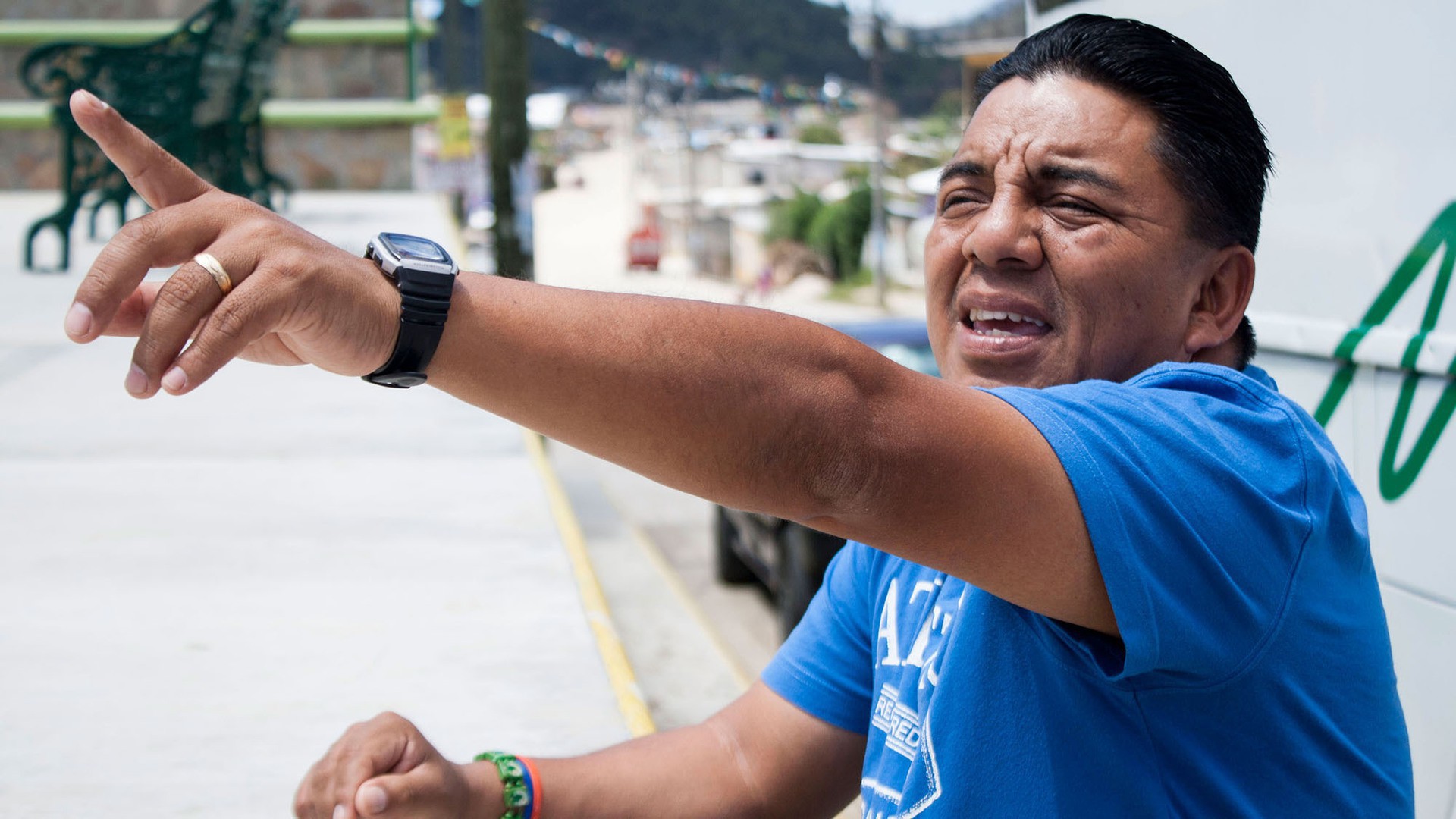
The government spends around 10,000 pesos – about $800 – to build a court, de la Cruz says. He reminisces about playing on them in his younger days.
“These courts have been here for a long time,” de la Cruz says. “I have no idea what started it all. It’s just a part of life.”
The game takes root
Miami Herald Latin America correspondent Andres Oppenheimer estimated that there were 3,700 basketball courts and 12,000 teams in Mexico’s southernmost state in 1996. Since then, that number has only grown, especially for the indigenous communities of Chiapas, who make up 12 of Mexico’s 62 officially recognized indigenous peoples.
Oppenheimer attributes the abundance of courts in Chiapas to a former governor. In his book, “Bordering on Chaos: Mexico’s Roller-Coaster Journey Towards Prosperity,” Oppenheimer explains:
“It turned out that Gen. Absalón Castellanos, a Chiapas governor in the 1980s, was a big basketball fan. Accordingly, he had included among the key elements of the federal government-sponsored 1982-1988 ‘Chiapas Plan’ construction of a basketball court in every Indian community. The general had decided that Indians needed sports, among other things, to help them stay away from drinking.”
But Steve Lewis, a history professor at California State University, Chico, thinks “the whole Absalón and his praise of basketball thing is almost an urban legend that took off in 1994.”
“A lot of people converged on Chiapas in 1994 (after the Zapatista rebellion) and certain stories gained traction, and that was one of them,” Lewis says. “It could well be that Absalón gave money to basketball courts and that he loved basketball, but it’s been a long-standing tradition.”
Lewis’ work has focused extensively on indigenous people in Mexico, namely in Chiapas. While researching historical documents for his book, “The Ambivalent Revolution: Forging State and Nation in Chiapas, Mexico, 1910-1945,” Lewis found that the government had been using basketball as a distraction from vice long before Castellanos was governor.
As early as the 1930s, he says, the policy known as “Social Education” aimed to “discourage alcohol and to encourage in its place sporting activities.”
“So they would build these basketball courts, organize competitions, and there would be all these patriotic rituals tied up with them. They would have the village band playing the national anthem and they’d have people marching around, military formation and that sort of thing,” he says. “So these basketball courts were there to kind of ‘improve the race’ and to distract from blood sport, alcohol and brothels.”
The ritual of a basketball game remains strong in the central highlands of Chiapas. In heavily Catholic Mexico, the indigenous celebrate patron saint days with a festival that always includes “torneos relámpagos,” or lightning-round tournaments.
With each community observing different saints’ days, it’s hard to determine how many times this actually occurs. But the Catholic Church says there are more than 10,000 named saints, each with his or her own celebrated day.
The basketball tournaments are accompanied by various events, including music, parades, and pre-Columbian ceremonies. But de la Cruz says that the basketball game is one of the most important activities during these celebrations.
“The games have to come first,” he says, laughing. “If not, the people get angry.”
Before the religious observance of Lent, the town of Chamula celebrates with a weeklong “carnaval.” A hybrid between Catholic and Mayan rituals, the Tzotzil people use palm fronds, incense, pyrotechnics – and basketball games throughout the celebration. It’s a source of pride for both the Tzotzil inhabitants and the town’s team, Los Fantasmas.
De la Cruz works closely with Chamula and Los Fantasmas. He has long-standing friendships with team members, like Beto Lopez, who runs a convenience store in town when he’s not on the courts.
“I’ve known Juanito for 12 years,” Lopez says, patting his companion on the back. “Our friendship is thanks to basketball.”
A homegrown movement
Throughout the time he’s known Lopez, de la Cruz has been a government representative. But the government cannot claim credit for Chamula’s athletic accomplishments.
Chamula is an autonomous municipality, independent of the Chiapas state government. The town provides its own police force – no state or federal police can operate there.
Los Fantasmas still participate in state-promoted basketball tournaments. But their involvement in the municipal leagues is on their own terms, as well as their own dime.
Just ask Los Fantasmas member Gerardo “Lalo” Lopez, another friend of de la Cruz’s, who raised money for the team’s uniforms.
“The government didn’t pay for our uniforms,” Lopez says, motioning to his dark-green jersey and tracksuit. “We got them because I knocked on doors.”
Chamula’s autonomy means the 50,000-person community is almost entirely responsible for providing for itself. But the municipality does promote physical education in the same vein that the government originally intended.
De la Cruz carries on that duty in Chamula’s primary school, Primaria Bilingue Benito Juarez Garcia, where he works with teachers and parents to put together “torneos relámpagos” for students. Without much government funding for the school, there is no physical-education program. Teachers take on double-duty in the classroom and on the school’s two courts, where they make time in the day to coach students.
Octavio Santis, a fifth-grade teacher at the school, is coaching his female students for the tournament. He says they’re picking up basketball quickly.

“We’ve already had the girls practice for the tournaments,” Santis says. “They’re learning how to pass, dribble, and shoot lay-ups. Their physical education is essential.”
Santis takes his fifth-grade girls out to the courts after the discussion, having them do drills and quick games. Some girls play in traditional Tzotzil garb – an indigo-dyed wrap, a blouse and a cotton sash.
Everyone at the school speaks both Spanish and Tzotzil in varying degrees: Because almost all of Chamula’s population is from the Tzotzil tribe, the school has a bilingual curriculum.
Instilling indigenous languages in the schools is not something embraced by Mexico’s government, which has pushed Spanish-only education since the Mexican Revolution in 1910.
In his book, “The Ambivalent Revolution,” Lewis wrote about how Mexico’s Secretariat of Public Education (SEP) thought that eliminating indigenous language in schools would help to unite the country: “Spanish was to be the only language spoken in Mexico’s educational ‘melting pot.’ (The SEP) had maintained that the destruction of indigenous languages was a necessary step toward national integration.”
A checkered history
While the century-old battle over language in schools remains unresolved, the government and the Tzotzil in Chamula have found common ground on the basketball courts. But the sport has not smoothed all issues between higher and lower classes in Chiapas.
At the time of the Zapatista rebellion in 1994, violence between government paramilitaries and the indigenous people of Chiapas was at its height. There were an estimated 3,000 members of the Zapatista Army of National Liberation (EZLN) who went head-to-head against Mexico and its army from Jan. 1 to Jan. 12 that year.
Zapatistas charge that the military and pro-government paramilitary groups have breached the Jan. 12 ceasefire through the years, often using the basketball courts in the highlands to their benefit. Oppenheimer wrote that some skeptics thought that Castellanos “had built the courts to use as landing platforms for military helicopters, as they (had been) used during the Zapatista insurrection.”
The worst breach came in 1997 in Chenalhó, a municipality of 27,000. Though not an official Zapatista community, some EZLN members and sympathizers live there. That prompted a paramilitary group known as the Red Mask to massacre 45 people in Acteal, a Chenalhó village. Four of the 45 slain were pregnant women, who reportedly had their fetuses torn from their bodies.

Zapatista supporters say the paramilitary acts are continuing, including a violent attack in July 2013 on Chenalhó’s basketball courts.
Mary-Ann Tenuto-Sanchez, a member of the Chiapas Support Committee, a volunteer group based in Oakland, Calif., was one of first to spread the spread word of the July 2013 attack. In a blog post for the Chiapas Support Committee site, she wrote:
“On July 20, two Zapatistas and one non-Zapatista were detained in the Puebla ejido in Chenalhó. The two Zapatistas were beaten and tied to posts on the basketball court and threatened with having gasoline poured on them and being set on fire. They were accused of poisoning a water tank in the community. The third man was arrested and beaten for protesting the treatment of the Zapatistas,” she wrote.
“All three were taken to the prosecutor in San Cristóbal (de las Casas) and placed in jail, where they were held for three days. They were not fed and did not receive medical treatment for their injuries. All three were released on July 23 (2013) due to a complete lack of evidence.”
There was no outward evidence of that type of discord this March. In the center of Chenalhó, the basketball backboards are painted with the slogan, “Unidos Hacemos Mejor Para Chenalhó” – together, we do better for Chenalhó.
The slogan notwithstanding, Juan de la Cruz knows the government he works for and the people he lives with don’t always see eye-to-eye.
He’s served 10 different secretaries, all with their own political affiliations, at the Ministry of Youth, Sports and Recreation. But de la Cruz has never cared which political party the secretaries belong to. It’s their actions that matter to him.
“The party that a secretary belongs to doesn’t matter to me,” de la Cruz says. “It’s what they do for my people.”

